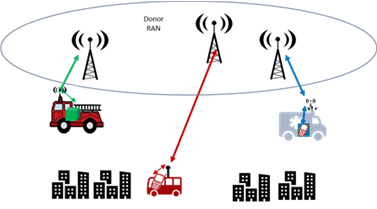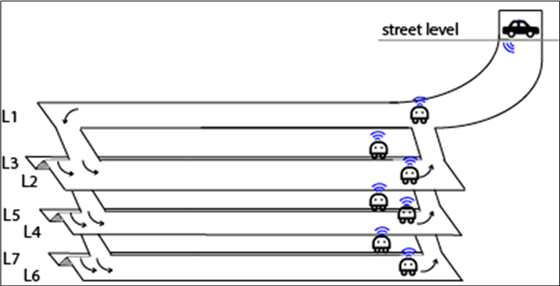Content for TR 22.839 Word version: 18.1.0
5.14 Optimized relay for in-vehicle devices p. 38
5.14.1 Description p. 38
There are scenarios where it is possible to improve performance of 5G UEs inside a vehicle, camped or connected via the vehicle relay to the 5G network, in particular when the UE is known to be located inside the vehicle. Some examples are:
- Medical devices in an ambulance (pre-installed, or portable)
- IOT/tracking devices used for goods delivery/transport, vehicle/asset monitoring, etc
- Cameras or other multi-media devices mounted on vehicles following an outdoor sport event
- Users' UEs that "check-in" their presence in the vehicle

5.14.2 Pre-conditions p. 38
Vehicle is equipped with a mobile BS station relay.
UEs can be pre-installed in the vehicle (permanently or semi-static), or can be portable and move in and out of the vehicle.
The UEs inside the vehicle, authorized to access the 5GS via the in-vehicle 5G mobile BS relay, are set to camp and connect (only or preferably) via the vehicle relay.
5.14.3 Service Flows p. 38
Pre-installed UEs are configured to access via the vehicle relay.
Portable IOT devices/wearables and/or UEs can "check-in" their presence/location in the vehicle, manually (e.g. user onboard, using UE's scan or app-based check-in), or based on some form of device-relay pairing (e.g. using 3GPP direct discovery/ranging, or other mechanisms).
The RAN/relay can optimize mobility configuration (e.g. minimizing/disabling reselections and handovers) and/or UE battery life (e.g. minimizing/avoiding UE measurements, etc.).
Radio signal and RF power settings could also be tuned to provide best link and connectivity quality for each device, if relative position between UE and relay is known.
5.14.4 Post-conditions p. 39
UEs inside the vehicle remain camped and connected all the time via the vehicle relay, with no unnecessary reselection/handover ping-pongs (to/from macro), experiencing very good performance and/or saving battery life.
5.14.5 Existing features partly or fully covering the use case functionality p. 39
Current stage-1 requirements (e.g. on wireless self-backhaul, in TS 22.261), as well as existing stage-2/3 functionalities and architecture options (e.g. IAB) do not assume or address full relay mobility (e.g. BS relays on board of moving vehicles), thus may not cover the identified new potential requirements, which are intended to be specific to mobile BS relays.
5.14.6 Potential New Requirements needed to support the use case p. 39
[PR.5.14.6-001]
The 5G system shall be able to support mechanisms to optimize mobility (e.g. re-selection, handover) and energy efficiency for a UE camped or connected via a vehicle mobile BS relay (e.g. for UEs located inside a vehicle, equipped with a BS relay).
5.15 Transient Coverage Extension p. 39
5.15.1 Description p. 39
Mobile wireless communications apply to outdoor scenarios. In remote areas, satellite access or self-backhaul provide a clear solution for extending the range of / complementing a mobile network.
For indoor scenarios, beyond the point where outdoor access penetrates, currently 3GPP offers two possibilities.
One is for the indoor premises to deploy non-3GPP access. Through this, a terminal can access a mobile network to get telecommunication services (or access Internet services directly.) This possibility is enabled since Release 7 (IWLAN interworking) by this and later 3GPP standards.
A second possibility is to offer coverage extension, indoors - either through wireless repeaters or a fixed infrastructure in the indoors premises. This is discussed in TR 22.867, Annex A.
A new possibility is presented in this use case - to make use of a number of vehicles to create a transient wireless topology of multiple vehicular relays capable of supporting indoor coverage where it would otherwise not be feasible.
A similar scenario was considered in FS_REFEC (clause 6.7 of TR 22.866) as a Traffic Scenario for Public Safety. A number of firefighters penetrate a building without indoor macro cellular coverage and deploy a set of portable (UE) relays in strategic places, e.g. the top and bottom of stairwells, as they access portions of the build with poor or no coverage otherwise.
In this use case, there is a large underground parking structure with no coverage nor is there an incentive or possibility (e.g. due to safety issues) to create fixed coverage extension. Other examples of this could be waste disposal sites, inactive mines, abandoned properties, search and rescue operations in challenging terrain in remote areas (e.g. caves), through underground intrastructure (e.g. sewers, water supply, transit tunnels) or building complexes where investment in coverage extension does not occur.

Figure 5.15.1-1: Underground Parking Garage with Transient Network Extension
(⇒ copy of original 3GPP image)
(⇒ copy of original 3GPP image)
Unlike the case studied in REFEC, this scenario involves vehicular mobile relays providing 5G coverage extension from outdoor to indoor.
5.15.2 Pre-conditions p. 40
The following are assumed to be available for this use case:
- 5G macro cellular coverage to the exterior of the facility into which transient coverage is required, e.g. to connect users, sensors or other IoT devices in the facility. In Figure 5.x.1-1, this is the vehicle parked across the entrance of the garage;
- a set of vehicles equipped with relays, configured to work together to provide a network topology. These vehicles could proceed autonomously, controlled remotely or be driven by personnel. In Figure 5.x.1-1, these are the mobile vehicle relay nodes.
- a topography consisting of regions that are accessible to vehicles, portions of which need coverage, even if temporarily or ad hoc coverage. In Figure 5.x.1-1, this is the concrete (and steel) underground parking complex shown only schematically.
5.15.3 Service Flows p. 40
The mobile relays proceed into the vicinity of the facility that lacks coverage, in this case the garage. Where necessary, vehicles remain in positions that advance the coverage into the topology. Other vehicles continue, to bring coverage specifically to portions of the facility that need it. The mobile relays topology may change depending on dynamic coverage demand, e.g the vehicle relays can move or reconfigure to provide access to different areas or moving users, when and where indoor coverage is required.
5.15.4 Post-conditions p. 40
Sensors and other IoT devices in the facility (for example air quality meters in the parking garage), as well as users who need only periodic connectivity (e.g. to upload and download data opportunistically), will receive connectivity from the transient coverage extension. This will enable data collection from a range of otherwise isolated devices and other communication on a periodic basis, or as needed (e.g. during a disaster response).
The service that is provided to the end systems is 3GPP service (not ProSe UE to network.)
5.15.5 Existing features partly or fully covering the use case functionality p. 40
NR Rel-16 introduces a relaying architecture enabling routing across a backhaul network of relay nodes which uses NR-Uu interface to interconet relay nodes, enabling data transfer from network access node to the end-user, and back: IAB. In Rel-17, IAB is currently being enhanced, although relay (IAB-node) mobility is not being taken into account.
5.15.6 Potential New Requirements needed to support the use case p. 41
[PR.5.15.6-001]
The 5G System shall be able to support dynamic deployment and configuration of one or more mobile base station relays (e.g. mounted on vehicles) for providing ad-hoc indoor coverage extension in specific locations.